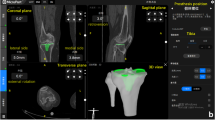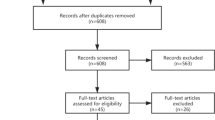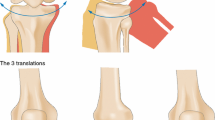Abstract
Introduction
Obesity has been associated with poorer outcomes following total knee arthroplasty (TKA); however, data remain sparse on its impact on patients’ joint awareness following surgery. This study aims to investigate the impact of body mass index (BMI) on improvement in outcomes following TKA as assessed by the Forgotten Joint Score-12 (FJS-12).
Materials and methods
We retrospectively reviewed 1075 patients who underwent primary TKA from 2017 to 2020 with available postoperative FJS-12 scores. Patients were stratified based on their BMI (kg/m2): < 30, 30.0–34.9 (obese class I), 35.0–39.9 (obese class II), and ≥ 40 (obese class III). FJS-12 and KOOS, JR scores were collected at various time points. Demographic differences were assessed with Chi-square and ANOVA tests. Mean scores between BMI groups were compared using univariate ANCOVA, controlling for observed demographic differences.
Results
Of the 1075 patients included, there were 457 with a BMI < 30, 331 who were obese class I, 162 obese class II, and 125 obese class III. There were no statistical differences in FJS-12 scores between the BMI groups at 3 months (27.24 vs. 25.33 vs. 23.57 vs. 22.48; p = 0.99), 1 year (45.07 vs. 41.86 vs. 40.51 vs. 36.22; p = 0.92) and 2 years (51.31 vs. 52.86 vs. 46.17 vs. 44.97; p = 0.94). Preoperative KOOS, JR scores significantly differed between the various BMI categories (49.33 vs. 46.63 vs. 44.24 vs. 39.33; p < 0.01); however, 3-month (p = 0.20) and 1-year (p = 0.13) scores were not statistically significant. Mean improvement in FJS-12 scores from 3 months to 2 years was statistically greatest for obese class I patients and lowest for obese class III patients (24.07 vs. 27.53 vs. 22.60 vs. 22.49; p = 0.01). KOOS, JR score improvement from baseline to 1 year was statistically greatest for obese class III patients and lowest for non-obese patients (22.34 vs. 25.49 vs. 23.77 vs. 27.58; p < 0.01).
Conclusion
While all groups demonstrated postoperative improvement, those with higher BMI reported lower mean FJS-12 scores but these differences were not found to be significant. Our study showed no significant impact of BMI on postoperative joint awareness, which implies that obese patients, in all obesity classes, experience similar functional improvement following TKA.
Level III Evidence
Retrospective Cohort Study.
Similar content being viewed by others
References
Finucane MM, Stevens GA, Cowan MJ et al (2011) National, regional, and global trends in body-mass index since 1980: Systematic analysis of health examination surveys and epidemiological studies with 960 country-years and 9·1 million participants. Lancet 377:557–567. https://doi.org/10.1016/S0140-6736(10)62037-5
Wang Y, Chen X (2011) How much of racial/ethnic disparities in dietary intakes, exercise, and weight status can be explained by nutrition- and health-related psychosocial factors and socioeconomic status among US adults? J Am Diet Assoc 111:1904–1911. https://doi.org/10.1016/j.jada.2011.09.036
Lohmander LS, De Verdier MG, Rollof J et al (2009) Incidence of severe knee and hip osteoarthritis in relation to different measures of body mass: A population-based prospective cohort study. Ann Rheum Dis 68:490–496. https://doi.org/10.1136/ard.2008.089748
Powell A, Teichtahl AJ, Wluka AE, Cicuttini FM (2005) Obesity: A preventable risk factor for large joint osteoarthritis which may act through biomechanical factors. Br J Sports Med 39:4–5
Gandhi R, Wasserstein D, Razak F et al (2010) BMI independently predicts younger age at hip and knee replacement. Obesity 18:2362–2366. https://doi.org/10.1038/oby.2010.72
Vasarhelyi EM, MacDonald SJ (2012) The influence of obesity on total joint arthroplasty. J Bone Jt Surg Ser B 94B:100–102
H-bo Si, Zeng Y, Shen B et al (2015) The influence of body mass index on the outcomes of primary total knee arthroplasty. Knee Surg Sport Traumatol Arthrosc 23:1824–1832
Adhikary SD, Liu WM, Memtsoudis SG et al (2016) Body mass index more than 45 kg/m2 as a cutoff point is associated with dramatically increased postoperative complications in total knee arthroplasty and total hip arthroplasty. J Arthroplasty 31:749–753. https://doi.org/10.1016/j.arth.2015.10.042
Odum SM, Springer BD, Dennos AC, Fehring TK (2013) National obesity trends in total knee arthroplasty. J Arthroplasty 28:148–151. https://doi.org/10.1016/j.arth.2013.02.036
Wagner ER, Kamath AF, Fruth K et al (2016) Effect of body mass index on reoperation and complications after total knee arthroplasty. J Bone Jt Surg - Am 98:2052–2060
Namba RS, Paxton L, Fithian DC, Lou SM (2005) Obesity and perioperative morbidity in total hip and total knee arthroplasty patients. J Arthroplasty. 7:46–50
Jain NB, Guller U, Pietrobon R et al (2005) Comorbidities increase complication rates in patients having arthroplasty. Clin Orthop Relat Res. https://doi.org/10.1097/01.blo.0000156479.97488.a2
George J, Piuzzi NS, Ng M et al (2018) Association between body mass index and thirty-day complications after total knee arthroplasty. J Arthroplasty 33:865–871. https://doi.org/10.1016/j.arth.2017.09.038
Järvenpää J, Kettunen J, Kröger H, Miettinen H (2010) Obesity may impair the early outcome of total knee arthroplasty. A prospective study of 100 patients. Scand J Surg 99:45–49
O’Neill SC, Butler JS, Daly A et al (2016) Effect of body mass index on functional outcome in primary total knee arthroplasty–a single institution analysis of 2180 primary total knee replacements. World J Orthop 7:664–669. https://doi.org/10.5312/wjo.v7.i10.664
Boyce L, Prasad A, Barrett M et al (2019) The outcomes of total knee arthroplasty in morbidly obese patients: a systematic review of the literature. Arch Orthop Trauma Surg 139:553–560
Schoffman DE, Wilcox S, Baruth M (2013) Association of body mass index with physical function and health-related quality of life in adults with arthritis. Arthritis 2013:1–10. https://doi.org/10.1155/2013/190868
Merle-Vincent F, Couris CM, Schott AM et al (2011) Factors predicting patient satisfaction 2 years after total knee arthroplasty for osteoarthritis. Jt Bone Spine 78:383–386. https://doi.org/10.1016/j.jbspin.2010.11.013
Scott CEH, Oliver WM, MacDonald D et al (2016) Predicting dissatisfaction following total knee arthroplasty in patients under 55 years of age. Bone Jt J 98B:1625–1634. https://doi.org/10.1302/0301-620X.98B12.BJJ-2016-0375.R1
Giesinger JM, Loth FL, MacDonald DJ et al (2018) Patient-reported outcome metrics following total knee arthroplasty are influenced differently by patients’ body mass index. Knee Surg Sport Traumatol Arthrosc 26:3257–3264. https://doi.org/10.1007/s00167-018-4853-2
Baker P, Petheram T, Jameson S et al (2012) The association between body mass index and the outcomes of total knee arthroplasty. J Bone Joint Surg Am 94:1501–1508. https://doi.org/10.2106/JBJS.K.01180
Singh JA, Gabriel SE, Lewallen DG (2011) Higher body mass index is not associated with worse pain outcomes after primary or revision total knee arthroplasty. J Arthroplasty. https://doi.org/10.1016/j.arth.2010.02.006
Suleiman LI, Ortega G et al (2012) Does BMI affect perioperative complications following total knee and hip arthroplasty? J Surg Res 174:7–11. https://doi.org/10.1016/j.jss.2011.05.057
Chen JY, Lo NN, Chong HC et al (2016) The influence of body mass index on functional outcome and quality of life after total knee arthroplasty. Bone Jt J 98B:780–785. https://doi.org/10.1302/0301-620X.98B6.35709
Behrend H, Giesinger K, Giesinger JM, Kuster MS (2012) The “Forgotten Joint” as the ultimate goal in joint arthroplasty validation of a new patient-reported outcome measure. J Arthroplasty. https://doi.org/10.1016/j.arth.2011.06.035
Marx RG, Jones EC, Atwan NC et al (2005) Measuring improvement following total hip and knee arthroplasty using patient-based measures of outcome. J Bone Jt Surg - Ser A 87:1999–2005. https://doi.org/10.2106/JBJS.D.02286
Terwee CB, Bot SDM, de Boer MR et al (2007) Quality criteria were proposed for measurement properties of health status questionnaires. J Clin Epidemiol 60:34–42. https://doi.org/10.1016/j.jclinepi.2006.03.012
Eckhard L, Munir S, Wood D et al (2020) The ceiling effects of patient reported outcome measures for total knee arthroplasty. Orthop Traumatol Surg Res. https://doi.org/10.1016/j.otsr.2020.102758
Collins NJ, Roos EM (2012) Patient-reported outcomes for total hip and knee arthroplasty. commonly used instruments and attributes of a “Good” measure. Clin Geriatr Med 28:367–394
Adriani M, Malahias MA, Gu A et al (2020) Determining the validity, reliability, and utility of the forgotten joint score: a systematic review. J Arthroplasty 35:1137–1144. https://doi.org/10.1016/j.arth.2019.10.058
Hamilton DF, Loth FL, Giesinger JM et al (2017) Validation of the english language forgotten joint score-12 as an outcome measure for total hip and knee arthroplasty in a British population. Bone Jt J 99B:218–224. https://doi.org/10.1302/0301-620X.99B2.BJJ-2016-0606.R1
Giesinger JM, Kuster MS, Behrend H, Giesinger K (2013) Association of psychological status and patient-reported physical outcome measures in joint arthroplasty: A lack of divergent validity. Health Qual Life Outcomes. https://doi.org/10.1186/1477-7525-11-64
World Health Organization (2011) Fact Sheet Obesity and overweight. World Heal Organ 1–5
Giesinger JM, Kuster MS, Holzner B, Giesinger K (2013) Development of a computer-adaptive version of the forgotten joint score. J Arthroplasty 28:418–422. https://doi.org/10.1016/j.arth.2012.08.026
Thompson SM, Salmon LJ, Webb JM et al (2015) Construct validity and test re-test reliability of the forgotten joint score. J Arthroplasty 30:1902–1905. https://doi.org/10.1016/j.arth.2015.05.001
Holtz N, Hamilton DF, Giesinger JM et al (2020) Minimal important differences for the WOMAC osteoarthritis index and the forgotten joint score-12 in total knee arthroplasty patients. BMC Musculoskelet Disord 21:401. https://doi.org/10.1186/s12891-020-03415-x
Lyman S, Lee YY, McLawhorn AS et al (2018) What are the minimal and substantial improvements in the HOOS and KOOS and JR versions after total joint replacement? Clin Orthop Relat Res 476:2432–2441. https://doi.org/10.1097/CORR.0000000000000456
Behrend H, Zdravkovic V, Giesinger J, Giesinger K (2016) Factors predicting the forgotten joint score after total knee arthroplasty. J Arthroplasty 31:1927–1932. https://doi.org/10.1016/j.arth.2016.02.035
Järvenpää J, Kettunen J, Soininvaara T et al (2012) Obesity has a negative impact on clinical outcome after total knee arthroplasty. Scand J Surg 101:198–203. https://doi.org/10.1177/145749691210100310
Baumann F, Ernstberger T, Loibl M et al (2016) Validation of the German forgotten joint score (G-FJS) according to the COSMIN checklist: does a reduction in joint awareness indicate clinical improvement after arthroplasty of the knee? Arch Orthop Trauma Surg 136:257–264. https://doi.org/10.1007/s00402-015-2372-x
Thienpont E, Vanden Berghe A, Schwab PE et al (2016) Joint awareness in osteoarthritis of the hip and knee evaluated with the ‘Forgotten Joint’ Score before and after joint replacement. Knee Surg Sport Traumatol Arthrosc 24:3346–3351. https://doi.org/10.1007/s00167-015-3970-4
Husted H, Jørgensen CC, Gromov K et al (2016) Does BMI influence hospital stay and morbidity after fast-track hip and knee arthroplasty? Acta Orthop 87:466–472. https://doi.org/10.1080/17453674.2016.1203477
Blanco JF, Díaz A, Melchor FR et al (2020) Risk factors for periprosthetic joint infection after total knee arthroplasty. Arch Orthop Trauma Surg 140:239–245. https://doi.org/10.1007/s00402-019-03304-6
Lozano LM, Tió M, Rios J et al (2015) Severe and morbid obesity (BMI ≥ 35 kg/m2) does not increase surgical time and length of hospital stay in total knee arthroplasty surgery. Knee Surg Sport Traumatol Arthrosc 23:1713–1719. https://doi.org/10.1007/s00167-014-3002-9
Thienpont E, Zorman D (2016) Higher forgotten joint score for fixed-bearing than for mobile-bearing total knee arthroplasty. Knee Surg Sport Traumatol Arthrosc 24:2641–2645. https://doi.org/10.1007/s00167-015-3663-z
Issa K, Pivec R, Kapadia BH et al (2013) Does obesity affect the outcomes of primary total knee arthroplasty? J Knee Surg 26:89–94. https://doi.org/10.1055/s-0033-1341408
McElroy MJ, Pivec R, Issa K et al (2013) The effects of obesity and morbid obesity on outcomes in TKA. J Knee Surg 26:83–88
Ayyar V, Burnett R, Coutts FJ et al (2012) The influence of obesity on patient reported outcomes following total knee replacement. Arthritis 2012:1–6. https://doi.org/10.1155/2012/185208
Kiran A, Bottomley N, Biant LC et al (2015) Variations in good patient reported outcomes after total knee arthroplasty. J Arthroplasty 30:1364–1371. https://doi.org/10.1016/j.arth.2015.02.039
Baker PN, Rushton S, Jameson SS et al (2013) Patient satisfaction with total knee replacement cannot be predicted from pre-operative variables alone: A cohort study from the national joint registry for england and wales. Bone Jt J 95B:1359–1365. https://doi.org/10.1302/0301-620X.95B10.32281
Ast MP, Abdel MP, Lee YY et al (2014) Weight changes after total hip or knee arthroplasty: Prevalence, predictors, and effects on outcomes. J Bone Jt Surg - Am 97:911–919. https://doi.org/10.2106/JBJS.N.00232
Funding
In addition, there was no funding provided for this study. The records and existing data were de-identified and a part of our institutional quality improvement program; therefore, the present study was exempt from human-subjects review by our Institutional Review Board (IRB).
Author information
Authors and Affiliations
Corresponding author
Ethics declarations
Conflict of interest
The authors declare that they have no conflict of interest pertinent to this study.
Informed consent
Informed consent was obtained from all individual participants included in the study.
Additional information
Publisher's Note
Springer Nature remains neutral with regard to jurisdictional claims in published maps and institutional affiliations.
Rights and permissions
About this article
Cite this article
Singh, V., Yeroushalmi, D., Lygrisse, K.A. et al. The influence of obesity on achievement of a ‘forgotten joint’ following total knee arthroplasty. Arch Orthop Trauma Surg 142, 491–499 (2022). https://doi.org/10.1007/s00402-021-03840-0
Received:
Accepted:
Published:
Issue Date:
DOI: https://doi.org/10.1007/s00402-021-03840-0




